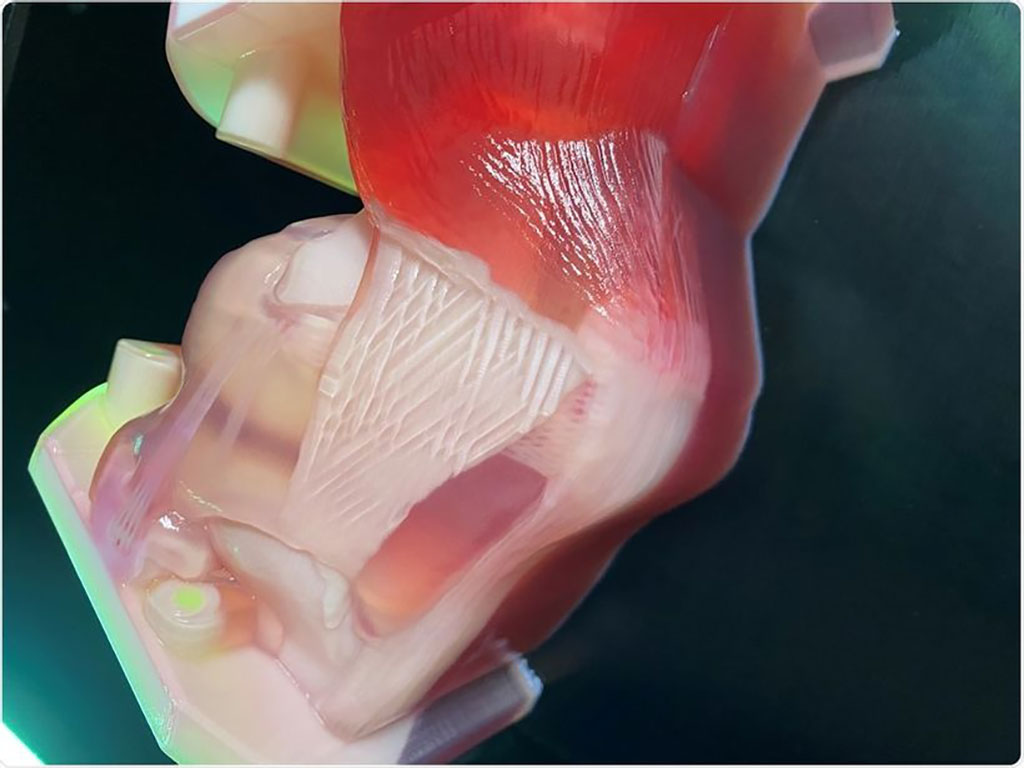3D Training Models Improve Orthopedic Surgeries
|
By HospiMedica International staff writers Posted on 12 Oct 2021 |

Image: A Fusetec 3D anatomical model (Photo courtesy of Fusetec)
New fully operable surgical simulation training models will help improve knee, hip, and spine surgical procedures.
Under development by Fusetec (Adelaide, Australia), in collaboration with Flinders University (Adelaide, Australia) and DePuy Synthes (West Chester, PA, USA), the three dimensional (3D) models reproduce all anatomical tissues and bone densities within the desired anatomy, and reproduce the relevant organs or joints to an accuracy of 20 microns among a wide range of features.
The manufactured body parts do not harbor any of the inherent risks associated with cadavers, since there are no bacteria, no strict storage and disposal protocols, and their use for training does not require any prohibitive regulatory burdens. The new models can also provide pathology on demand, meaning that complex surgical training can now also be rehearsed prior to undertaking potentially life-threatening operations. Advanced bio-model workshops will be held by DePuy Synthes, which will trial the Fusetec anatomical models as part of the surgical training.
“Most first-year surgical residents are performing dissections for the very first time on extremely expensive cadavers, or on real patients at a high-risk to both the patients and the surgical residents,” said Mark Roe, CEO of Fusetec. “So, we decided to manufacture highly realistic human body parts for surgical training purposes. Students learn how to hold a scalpel, how to make a cut, and how to use other medical implements before practicing on human beings.”
3D-printed models for pre-surgical planning allow for precise planning and simulation of the surgical approach, incision, and hardware sizing and placement. Physical 3D models can also serve as cutting guides for resection and as templates for the shaping of reconstruction hardware, implants, and prostheses so as to fit a patient's anatomy. It can also capture patient variability for education and training and provide easily interpretable visual guides for improving doctor–patient communication.
Related Links:
Fusetec
Flinders University
DePuy Synthes
Under development by Fusetec (Adelaide, Australia), in collaboration with Flinders University (Adelaide, Australia) and DePuy Synthes (West Chester, PA, USA), the three dimensional (3D) models reproduce all anatomical tissues and bone densities within the desired anatomy, and reproduce the relevant organs or joints to an accuracy of 20 microns among a wide range of features.
The manufactured body parts do not harbor any of the inherent risks associated with cadavers, since there are no bacteria, no strict storage and disposal protocols, and their use for training does not require any prohibitive regulatory burdens. The new models can also provide pathology on demand, meaning that complex surgical training can now also be rehearsed prior to undertaking potentially life-threatening operations. Advanced bio-model workshops will be held by DePuy Synthes, which will trial the Fusetec anatomical models as part of the surgical training.
“Most first-year surgical residents are performing dissections for the very first time on extremely expensive cadavers, or on real patients at a high-risk to both the patients and the surgical residents,” said Mark Roe, CEO of Fusetec. “So, we decided to manufacture highly realistic human body parts for surgical training purposes. Students learn how to hold a scalpel, how to make a cut, and how to use other medical implements before practicing on human beings.”
3D-printed models for pre-surgical planning allow for precise planning and simulation of the surgical approach, incision, and hardware sizing and placement. Physical 3D models can also serve as cutting guides for resection and as templates for the shaping of reconstruction hardware, implants, and prostheses so as to fit a patient's anatomy. It can also capture patient variability for education and training and provide easily interpretable visual guides for improving doctor–patient communication.
Related Links:
Fusetec
Flinders University
DePuy Synthes
Latest Surgical Techniques News
- Minimally Invasive Endoscopic Surgery Improves Severe Stroke Outcomes
- Novel Glue Prevents Complications After Breast Cancer Surgery
- Breakthrough Brain Implant Enables Safer and More Precise Drug Delivery
- Bioadhesive Sponge Stops Uncontrolled Internal Bleeding During Surgery
- Revolutionary Nano Bone Material to Accelerate Surgery and Healing
- Superior Orthopedic Implants Combat Infections and Quicken Healing After Surgery
- Laser-Based Technique Eliminates Pancreatic Tumors While Protecting Healthy Tissue
- Surgical Treatment of Severe Carotid Artery Stenosis Benefits Blood-Brain Barrier
- Revolutionary Reusable Duodenoscope Introduces 68-Minute Sterilization
- World's First Transcatheter Smart Implant Monitors and Treats Congestion in Heart Failure
- Hybrid Endoscope Marks Breakthrough in Surgical Visualization
- Robot-Assisted Bronchoscope Diagnoses Tiniest and Hardest to Reach Lung Tumors
- Diamond-Titanium Device Paves Way for Smart Implants that Warn of Disease Progression
- 3D Printable Bio-Active Glass Could Serve as Bone Replacement Material
- Spider-Inspired Magnetic Soft Robots to Perform Minimally Invasive GI Tract Procedures
- Micro Imaging Device Paired with Endoscope Spots Cancers at Earlier Stage
Channels
Critical Care
view channel
Light-Based Technology to Measure Brain Blood Flow Could Diagnose Stroke and TBI
Monitoring blood flow in the brain is crucial for diagnosing and treating neurological conditions such as stroke, traumatic brain injury (TBI), and vascular dementia. However, current imaging methods like... Read more
AI Heart Attack Risk Assessment Tool Outperforms Existing Methods
For decades, doctors have relied on standardized scoring systems to assess patients with the most common type of heart attack—non-ST-elevation acute coronary syndrome (NSTE-ACS). The GRACE score, used... Read morePatient Care
view channel
Revolutionary Automatic IV-Line Flushing Device to Enhance Infusion Care
More than 80% of in-hospital patients receive intravenous (IV) therapy. Every dose of IV medicine delivered in a small volume (<250 mL) infusion bag should be followed by subsequent flushing to ensure... Read more
VR Training Tool Combats Contamination of Portable Medical Equipment
Healthcare-associated infections (HAIs) impact one in every 31 patients, cause nearly 100,000 deaths each year, and cost USD 28.4 billion in direct medical expenses. Notably, up to 75% of these infections... Read more
Portable Biosensor Platform to Reduce Hospital-Acquired Infections
Approximately 4 million patients in the European Union acquire healthcare-associated infections (HAIs) or nosocomial infections each year, with around 37,000 deaths directly resulting from these infections,... Read moreFirst-Of-Its-Kind Portable Germicidal Light Technology Disinfects High-Touch Clinical Surfaces in Seconds
Reducing healthcare-acquired infections (HAIs) remains a pressing issue within global healthcare systems. In the United States alone, 1.7 million patients contract HAIs annually, leading to approximately... Read moreHealth IT
view channel
Printable Molecule-Selective Nanoparticles Enable Mass Production of Wearable Biosensors
The future of medicine is likely to focus on the personalization of healthcare—understanding exactly what an individual requires and delivering the appropriate combination of nutrients, metabolites, and... Read moreBusiness
view channel
Philips and Masimo Partner to Advance Patient Monitoring Measurement Technologies
Royal Philips (Amsterdam, Netherlands) and Masimo (Irvine, California, USA) have renewed their multi-year strategic collaboration, combining Philips’ expertise in patient monitoring with Masimo’s noninvasive... Read more
B. Braun Acquires Digital Microsurgery Company True Digital Surgery
The high-end microsurgery market in neurosurgery, spine, and ENT is undergoing a significant transformation. Traditional analog microscopes are giving way to digital exoscopes, which provide improved visualization,... Read more
CMEF 2025 to Promote Holistic and High-Quality Development of Medical and Health Industry
The 92nd China International Medical Equipment Fair (CMEF 2025) Autumn Exhibition is scheduled to be held from September 26 to 29 at the China Import and Export Fair Complex (Canton Fair Complex) in Guangzhou.... Read more














